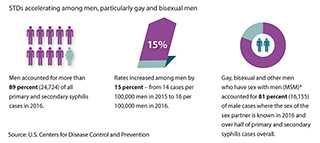2016 STD Surveillance Report
September 26, 2017 – STDs at record high, threatening the health of millions of Americans
New CDC data for three nationally reported STDs – chlamydia, gonorrhea, and syphilis—reveal more than 2 million cases were diagnosed in 2016. CDC estimates that closer to 20 million infections occur annually.
The majority of these diagnoses (1.6 million) were cases of chlamydia. There were also 470,000 gonorrhea cases and almost 28,000 cases of primary and secondary syphilis – the most infectious stages of the disease. While young people, particularly young women aged 15-24, continue to bear the greatest burden of STDs, surges in syphilis and gonorrhea are increasingly affecting new populations.
Resources:
- Press Release: STDs at record high, urgent need for prevention
- Full Report: Sexually Transmitted Disease Surveillance, 2016
- Fact Sheet: Reported STDs in the United States, 2016 [PDF – 158 KB]
Graphics: STD Surveillance Report 2016
The following images and graphics highlight major findings from CDC’s analysis and provide additional context. These high-resolution, public domain images are ready to download and print in your publication. Click on a graphic to see it in high-resolution.
These images are in the public domain and are thus free of any copyright restrictions. As a matter of courtesy, we ask that the content provider be credited and notified of any public or private usage of an image.

Increase in syphilis among newborns is accelerating
The increase in the number of cases of syphilis among newborns between 2014 and 2016 has accelerated. In 2014 there were 461 reported cases of congenital syphilis, in 2015 there were 492 reported cases of congenital syphilis, and in 2016 there 628 reported cases of congenital syphilis. This surge threatens the health of a new generation of Americans.

Burden of syphilis highest among men, particularly gay and bisexual
The burden of syphilis was highest among men, particularly gay and bisexual men. Men accounted for more than 89 percent (24,724 cases) of all primary and secondary syphilis cases in 2016. Men who have sex with men accounted for 81 percent (16,155 cases) of male cases where the sex of the sex partner is known in 2016. Syphilis among men increased about 15 percent between 2015 and 2016, from 14 cases per 100,000 men in 2015 to 16 cases per 100,000 men in 2016
- Page last reviewed: September 26, 2017
- Page last updated: September 26, 2017
- Content source:


 ShareCompartir
ShareCompartir




